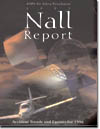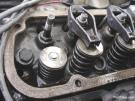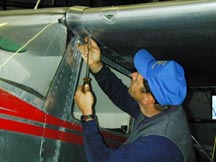 I guess if I really thought about it, I would have to question my sanity as to why I am willing to put so much trust into that one infernal combustion engine that propels me through the sky.  It rumbles, it vibrates, and has a zillion moving parts anyone of which could let go at the wrong time.  In spite of all this and its ancient design, a fatal accident resulting from an engine failure on a single engine plane is relatively low on the statistical totem pole if you play your cards right.
I guess if I really thought about it, I would have to question my sanity as to why I am willing to put so much trust into that one infernal combustion engine that propels me through the sky.  It rumbles, it vibrates, and has a zillion moving parts anyone of which could let go at the wrong time.  In spite of all this and its ancient design, a fatal accident resulting from an engine failure on a single engine plane is relatively low on the statistical totem pole if you play your cards right.
 The Nall report (available on-line at http://www.aopa.org/asf/publications/nall.html) provides a statistical overview of general aviation accidents on an annual basis.  In 2002 there were a total of 19 fatal accidents that were attributable to a mechanical or maintenance failure of the engine or propeller.  There were another 223 accidents in this same category that did not result in any fatalities.  Although not entirely risk free, when one considers the millions of uneventful operational hours that are racked up in piston aircraft every year, our antiquated propulsion system serves us relatively well.  As you will see, there are some practical ways to reduce the risk of an unexpected engine noise reduction event even further.
The Nall report (available on-line at http://www.aopa.org/asf/publications/nall.html) provides a statistical overview of general aviation accidents on an annual basis.  In 2002 there were a total of 19 fatal accidents that were attributable to a mechanical or maintenance failure of the engine or propeller.  There were another 223 accidents in this same category that did not result in any fatalities.  Although not entirely risk free, when one considers the millions of uneventful operational hours that are racked up in piston aircraft every year, our antiquated propulsion system serves us relatively well.  As you will see, there are some practical ways to reduce the risk of an unexpected engine noise reduction event even further.
Pay attention to any out of the ordinary changes in engine or prop operation.
 In one of the fatal accidents I investigated, the pilot had experienced a “stuck valve” on takeoff about a month prior to the accident flight.  He was also aware that the engine had been burning oil at a fairly high rate.  The engine seemed to otherwise run normally so he continued to fly.  On a night flight over rough terrain an exhaust valve broke causing a power loss and subsequent engine failure with fatal results.  The reason for the valve failure was never conclusively determined, but the engine tried to tell the pilot early on that all was not well.
In one of the fatal accidents I investigated, the pilot had experienced a “stuck valve” on takeoff about a month prior to the accident flight.  He was also aware that the engine had been burning oil at a fairly high rate.  The engine seemed to otherwise run normally so he continued to fly.  On a night flight over rough terrain an exhaust valve broke causing a power loss and subsequent engine failure with fatal results.  The reason for the valve failure was never conclusively determined, but the engine tried to tell the pilot early on that all was not well.
In another instance, a pilot noticed that his aircraft had developed a vibration that he thought was coming from the prop.  He had the prop dynamically balanced to counter-act the vibration, but it would not go away completely.  While in flight one prop blade broke off and the airplane crashed resulting in serious injuries.  It was suspected that the vibration originated in the engine, possibly due to a bad counterweight.  This created a harmonic stress and fatigue cycle that caused the prop blade to fail.  As in the prior accident, there had been subtle warnings that something was not mechanically right.
Be extra cautious when maintenance work has been done on the aircraft or engine.
 I’ve investigated several engine failure accidents on the first flight out of the shop.  I have seen engine failure accidents resulting from improperly secured fuel lines, oil lines, drain plugs, throttle cables and a whole host of other mechanic-induced causes.  I once picked up a plane right after an annual inspection.  On the take-off roll, I noticed a fuel flow fluctuation and aborted.  After taxiing back to do another run-up, I found that the manifold pressure was way below normal.  The shop had re-installed the turbo-charger oil line check valve backwards which cut off oil flow to the turbo.  The lack of lubrication destroyed the turbo and would have resulted in an in-flight power loss had I not aborted the take-off on the first attempt.
I’ve investigated several engine failure accidents on the first flight out of the shop.  I have seen engine failure accidents resulting from improperly secured fuel lines, oil lines, drain plugs, throttle cables and a whole host of other mechanic-induced causes.  I once picked up a plane right after an annual inspection.  On the take-off roll, I noticed a fuel flow fluctuation and aborted.  After taxiing back to do another run-up, I found that the manifold pressure was way below normal.  The shop had re-installed the turbo-charger oil line check valve backwards which cut off oil flow to the turbo.  The lack of lubrication destroyed the turbo and would have resulted in an in-flight power loss had I not aborted the take-off on the first attempt.
One fatal accident I investigated occurred right after a pilot picked up his aircraft at a shop that had just completed a top-end engine overhaul.  The pilot was proceeding home at night and only thirty minutes into the flight the engine started to run rough.  He could not maintain altitude and was killed when the aircraft collided with a power transmission tower.  It was later determined that the shop’s improper installation of a valve keeper allowed a valve to drop down into the cylinder.  Had the pilot made the flight during daylight hours he likely would have seen the tower and made a survivable off airport landing since the surrounding terrain was flat farm land.
 My philosophy on flying an aircraft after maintenance is simple:  The first flight is a test flight to be conducted during day VFR over good terrain.  The preflight and ground checks should be meticulous with full control checks and engine run-ups.  Look for oil and fuel leakage and any smoke.  Pay particular attention to the engine instruments during take-off and climb-out and be mentally prepared for the possibility of a forced landing.
My philosophy on flying an aircraft after maintenance is simple:  The first flight is a test flight to be conducted during day VFR over good terrain.  The preflight and ground checks should be meticulous with full control checks and engine run-ups.  Look for oil and fuel leakage and any smoke.  Pay particular attention to the engine instruments during take-off and climb-out and be mentally prepared for the possibility of a forced landing.
If any significant maintenance work was performed, remain in the airport pattern for the test flight and upon landing remove the cowling to re-inspect.  A mechanic once left his flashlight (the big D-cell kind, not a little one) in my engine cowl after routine maintenance.  I unknowingly flew around with it lying inside the engine compartment for the next 10 flight hours.  My choice of words upon discovering was, well, let’s say “colorful” and not suitable for print here.
The Rest is Up to You.
Everything comes down to playing the odds and putting them in your favor When an engine starts talking to you pay attention.  As demonstrated earlier, engines can provide subtle clues when all is not well and ignoring an abnormality increases the future likelihood of becoming a statistic.  Failing to properly maintain your aircraft is another way to stack the odds against you.  Routine annuals are fine, but preventative maintenance is even better.  How old are your fuel and oil lines?  When was the last time your magnetos were inspected?  Don’t try to get by with the cheapest annual just to satisfy the regulations.  Yes, I am well aware of how expensive good maintenance is, but I can think of more costly consequences from not doing it right.  Here is some tough love:  If you can’t afford to properly maintain an aircraft, do yourself a favor and sell it.
That brings us to the final issue of playing the odds.  Ask yourself where you don’t want to be if the engine fails.  Flying over inhospitable terrain is a normal part of flying, but it can be mitigated. For example, when I fly across the Sierras I will follow the highways rather than go directly over the mountains.  It takes a few extra minutes, but it increases the odds that a forced landing will be survivable.  Where there are no highways I add extra altitude to increase gliding distance.  Night or IFR over the mountains on one engine?  Not for me, but we all have different levels of risk tolerance.
Editor’s Note: This article was written by Ken Steiner prior to his retirement from the United States Aircraft Insurance Group as a Vice-President and Claims Manager. During his career, Ken investigated thousands of aircraft accidents involving small planes, crop dusters, helicopters, corporate aircraft, and airliners. He has been on-site at over 100 fatal aircraft accident investigations. He is currently an Aviation Investigative Consultant and is also a Pilot and Tactical Flight Officer for the San Mateo County Sheriff’s Air Support Unit. He owns a Cessna 182 based at San Carlos and holds ATP and CFI certificates with over 5000 flying hours.



